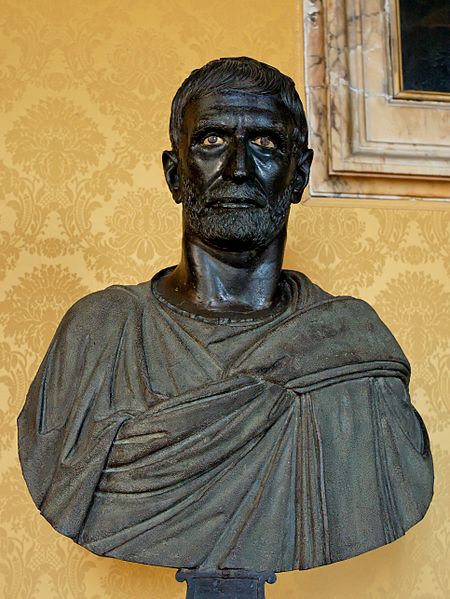The gens Junia or Iunia was one of the most celebrated families of ancient Rome. The gens may originally have been patrician, and was already prominent in the last days of the Roman monarchy. Lucius Junius Brutus was the nephew of Lucius Tarquinius Superbus, the seventh and last King of Rome, and on the expulsion of Tarquin in 509 BC, he became one of the first consuls of the Roman Republic.
Bust in the Capitoline Museums, traditionally identified as Lucius Junius Brutus
Denarius of Decimus Junius Silanus, 91 BC. The obverse depicts a mask of Silenus within a torque, alluding to both the surname Silanus and their descent from the Manlii Torquati, and a plough, perhaps alluding to the dictator Gaius Junius Bubulcus Brutus. On the reverse Victoria drives a biga over a carnyx.
Denarius of Marcus Junius Brutus, 54 BC, depicting Lucius Junius Brutus on the obverse, and Gaius Servilius Ahala on the reverse. The tyrannicide Brutus claimed both as ancestors.
Denarius of Marcus Junius Silanus, 145 BC. The obverse depicts Roma in front of a donkey's head, alluding to Silenus. The Dioscuri appear on the reverse.
The patricians were originally a group of ruling class families in ancient Rome. The distinction was highly significant in the Roman Kingdom and the early Republic, but its relevance waned after the Conflict of the Orders. By the time of the late Republic and Empire, membership in the patriciate was of only nominal significance. The social structure of ancient Rome revolved around the distinction between the patricians and the plebeians. The status of patricians gave them more political power than the plebeians, but the relationship between the groups eventually caused the Conflict of the Orders. This time period resulted in changing of the social structure of ancient Rome.
Romulus and his brother, Remus, with the she-wolf. Romulus is credited with creating the patrician class.





